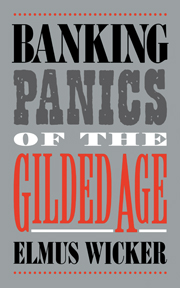Book contents
- Frontmatter
- Contents
- Preface
- 1 The Bank Panic Experience: An Overview
- 2 The Banking Panic of 1873
- 3 Two Incipient Banking Panics of 1884 and 1890: An Unheralded Success Story
- 4 The Banking Panic of 1893
- 5 The Trust Company Panic of 1907
- 6 Were Panics of the National Banking Era Preventable?
- 7 Epilogue
- Appendix
- References
- Index
5 - The Trust Company Panic of 1907
Published online by Cambridge University Press: 21 October 2009
- Frontmatter
- Contents
- Preface
- 1 The Bank Panic Experience: An Overview
- 2 The Banking Panic of 1873
- 3 Two Incipient Banking Panics of 1884 and 1890: An Unheralded Success Story
- 4 The Banking Panic of 1893
- 5 The Trust Company Panic of 1907
- 6 Were Panics of the National Banking Era Preventable?
- 7 Epilogue
- Appendix
- References
- Index
Summary
Fourteen years had elapsed since the last serious banking disturbance in 1893. No attempt had been made in the interim to devise a strategy for preventing banking panics. The association of NYCH banks was still a loose alliance of fifty-two member banks with deposits totaling more than $1 billion. Thirty-three banks including state banks and trust companies remained outside with deposits of almost $800 million. Although prepared to act in the interest of all NYCH banks, the NYCH was not disposed to offer direct financial support to nonmembers even if withholding support increased the risk of failure to themselves. Its responsibility for preventing banking panics, well understood before 1873, had by now been mostly forgotten. The absence of strong leadership gave dissident voices in the Clearing House the opportunity to express purely self-serving interests at the expense of those who had a clear understanding of the broader role of the association of New York banks.
Three characteristics of the 1907 panic render it unique among the banking panics of the national banking era: (1) the disturbance in New York was largely confined to the trust companies; (2) leadership for restoring banking stability was assumed by J. P. Morgan and not the New York Clearing House; and (3) the instrument of voluntary money pooling was used extensively to provide financial support to troubled trust companies and the stock market, and to relieve the fiscal crisis in New York City.
- Type
- Chapter
- Information
- Banking Panics of the Gilded Age , pp. 83 - 113Publisher: Cambridge University PressPrint publication year: 2000

